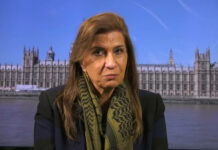 Investors’ despair about financial companies and the recession has brought the Dow Jones industrial average to another unwanted milestone: its first drop below 7,000 in more than 11 years. The market’s slide today, which took the Dow down 300 points, was nowhere near the largest it has seen since last fall, but the tumble below 7,000 was nonetheless painful. The credit crisis and recession have slashed more than half the average’s value since it hit a record high over 14,000 in October 2007. And now many investors fear the market could take a long time to regain the lost 7,000.”As bad as things are, they can still get worse, and get a lot worse,” said Bill Strazzullo, chief market strategist for Bell Curve Trading. Strazzullo said he believes there’s a significant chance the S&P 500 and the Dow will fall back to their 1995 levels of 500 and 5,000, respectively.
Investors’ despair about financial companies and the recession has brought the Dow Jones industrial average to another unwanted milestone: its first drop below 7,000 in more than 11 years. The market’s slide today, which took the Dow down 300 points, was nowhere near the largest it has seen since last fall, but the tumble below 7,000 was nonetheless painful. The credit crisis and recession have slashed more than half the average’s value since it hit a record high over 14,000 in October 2007. And now many investors fear the market could take a long time to regain the lost 7,000.”As bad as things are, they can still get worse, and get a lot worse,” said Bill Strazzullo, chief market strategist for Bell Curve Trading. Strazzullo said he believes there’s a significant chance the S&P 500 and the Dow will fall back to their 1995 levels of 500 and 5,000, respectively.
The “game-changer,” he said, will be the housing market and whether it can stabilize.
A recovery will also require signs of health among financial companies, but so far in 2009, it is clear that banks and insurance companies’ losses are multiplying despite hundreds of billions of dollars in government help. The market fell Monday after insurer American International Group Inc. posted a staggering $61.7 billion in quarterly losses and as the government agreed to inject more money into the company. AIG will get another $30 billion in loans, on top of the $150 billion the government has already invested.
And it’s not just U.S. companies that have Wall Street frightened. HSBC PLC, Europe’s largest bank by market value, said Monday it needs to raise $17.7 billion. The company reported a 70 percent drop in 2008 earnings and said it would cut 6,100 jobs.
While the root of financial firms’ problems lie with the bad bets they made on mortgages and mortgage-backed securities, now the recession is exacerbating their problems as it also forces millions of job cuts.
“The economy definitely has deteriorated since November,” said Sean Simko, head of fixed income management at SEI Investments. “It’s just the fact that we haven’t seen signs of improving or stabilizing, per se, which is adding to the morass of the market.”
According to preliminary calculations, the Dow fell 299.64, or 4.24 percent, to 6,763.29. The Dow last closed below 7,000 on May 1, 1997 and hadn’t finished at this level since April 25, 1997.
The Dow’s descent has been swift. It took only 14 sessions for the average to go from above 8,000 to below 7,000. So far this year, the Dow is down 22.9 percent.
Broader stock indicators also slid. The Standard & Poor’s 500 index fell 34.27, or 4.7 percent, to 700.82. The index briefly traded below the 700 mark in the final minutes of the session. S&P 500 index hadn’t traded below 700 since Oct. 29, 1996. It hasn’t closed below that level since the previous day, Oct. 28.
The Nasdaq composite index fell 54.99, or 4 percent, to 1,322.85.
The Russell 2000 index of smaller companies fell 21.22, or 5.5 percent, to 367.80.
About 16 stocks fell for every one that rose on the New York Stock Exchange, where volume came to a heavy 1.80 billion shares.
{AP/Matzav.com Newscenter}











